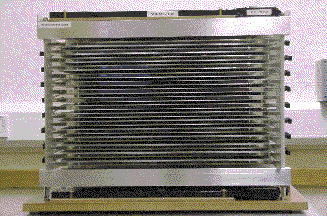
A Spark Chamber is a device used for
detecting charged particles. It is one of many detector devices used by elementary particle physicists in the search for a greater understanding of the subatomic particles which make up the universe.In current research the spark chamber has become largely redundant, as it has been replaced by detectors of higher sophistication which, for example have improved time and spatial resolution. For example:
The OPAL experiment at Large Electron-Positron (LEP) accelerator at CERN http://www.cern.ch uses drift chambers, whilst in the forthcoming ATLAS project silicon detectors will be used http://www.ep.ph.bham.ac.uk. These detectors measure the trajectories of different charged particles.
However the spark chamber is still of great scientific value in that it remains relatively simple and cheap to build as well as enabling an observer to view the paths of charged particles.

Figure 1: A transportable spark chamber, designed, built and tested by the Particle Physics research group at the University of Birmingham
.Figure 1 shows a transportable spark chamber built over the past two years by the Particle Physics group of the University of Birmingham. This particular model is a good tool for demonstrating particle physics. However as a research tool it would be extremely limited in its usage. Spark chambers in real research, would, for example often be used in conjunction with a large magnetic field, which would deflect particles. Different particles would be deflected different amounts by the magnetic fields, the bending in the magnetic field allows the particle's momentum to be determined.
Below is a brief history of the milestones in the development of the spark chamber, which hopefully give an insight into the key stages which occurred in the development of the spark chamber as a particle detector.
A Brief history of the major milestones in the life of the Spark Chamber
| Date | Person | Achievement |
| 1949 | Keuffel | First observed the discharge between parallel plates. He found that the discharge occurred along the physical path taken by the passage of a cosmic ray through the discharge. Thparticles. |
| 1953 | Bella / Frazinetti | Published photographs of the first spark discharge |
| 1955 | Hennings / Bagge | Made several improvements:
(1) Used several parallel plate counters (2) Enhanced the spark with a triggered condenser discharge (e.g. Argon or Alcohol) (3) Took stereo photographs |
| 1957 | Harwell / Cranshaw /
de Beer |
Looked into applying the high voltage to the plates immediately after the charged particle had passed through the spark chamber. They also developed the triggering of the chamber. |
| 1959 | Fukui / Migamoto | Introduced the possibility of observing more than one particle at once in the spark chamber, as well as using a noble gas in the chamber as well as applying the high voltage to the plates even more rapidly |
| 1963 | Alikhanian | Introduced the idea of creating a chamber where the gap between plates was wide enough to be able to observe spark trails of up to 20cm. |
| Early 1970's | Various | The spark chamber was one of the principal detectors used in particle physics experiments. |
| 1980's-2000 | Spark chambers are largely redundant in current research having been replaced by detectors of higher spatial and time resolution, for example drift chambers and silicon detectors. |
Return to the home page